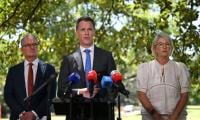Pakistan’s major gains on the ground, and in the air, to be precise, made during the recent conflict with India are slowly but surely also shaping Pakistan's image and how the rest of the world sees it.
It is now being seen for what the conflict in May did for the power matrix in South Asia: that India does not have any advantage as such in conventional warfare over Pakistan and that the Pakistan Air Force is far superior in training, tactics and execution than the Indian Air Force.
The fact that India exercises significant civilian control over its armed forces and that this has over the years reduced the efficiency and fighting capability of its armed forces was also clearly on display during the conflict, when after the first day battle in the air, India had no choice but to ground its entire air force, for fear of losing more jets to a far superior enemy. Even the deal that brought India its much-prized Rafale fighter jets from Dassault in France was controversial, with a close friend of Modi – and one of India’s wealthiest businessmen – playing a key role in procuring the jets.
As these developments happened, some other skeletons came out of the proverbial cupboard. India’s air chief Air Chief Marshal Amar Preet Singh publicly said that the government made many promises in terms of equipment and so on, but in most cases, these either failed to materialise or were subject to inordinate delays. The lack of planning, the bureaucracy and the inertia over the years had clearly had an impact on the Indian armed forces, and in this particular conflict it was all too evident in the operation of the Indian Air Force and how badly it performed.
The bad performance of the Indian Air Force, and concomitantly, the excellent performance of the Pakistan Air Force on the first night of the war must have surprised many across the world. And that very tangible outcome is now making an equally tangible impact on how the rest of the world sees and deals with Pakistan and India.
We first take a look at how the delegations sent by Pakistan and India to various important world capitals in the past 10-14 days have fared. India’s main delegation has been led ironically by a member of the Lok Sabha from the opposition Congress party, indicating that the ruling BJP couldn’t find a single MP from its own benches who was articulate and spoke English well before foreign audiences. India sought support from various African countries as well, including Liberia and Sierra Leone, where the head of its delegation to Africa spoke before a local audience in Hindi. Then there was the instance of a delegation going to Colombia, where it was embarrassed when the government of that country also expressed sympathy for the Pakistanis killed in the recent conflict.
India’s insecurities and bullying mindset are now so ingrained that it took this very natural response to a human tragedy in a conflict that affected both parties as an affront and demanded that Colombia retract its sympathy for the Pakistanis who had died.
Even the otherwise pliant and servile mainstream Indian media saw flashes of some neutrality in this when some of the guests who were invited on the news shows of various channels raised questions about the effectiveness of the delegations sent overseas. In most cases, what the delegations were saying was something that most Indians would readily agree with but as far as foreign audiences were concerned, it seemed that there were few buyers for India’s narrative. Indian social media was also awash with considerable criticism of
As for Pakistan’s delegation, led by former foreign minister Bilawal Bhutto Zardari, who is known to be an excellent and articulate speaker in English, it found a ready audience almost everywhere it went.
In the US, the most important audience for both Pakistan and India (notwithstanding Modi’s refusal so far to acknowledge the role played by US President Donald Trump and his team in the ceasefire), the Pakistani delegation met several members of the US Senate as well as the House of Representatives. Mr Bhutto-Zardari also spoke at a leading think-tank in Washington DC and appeared on various US news channels to press Pakistan’s narrative.
As he later told reporters in London after speaking at various forums in New York at the United Nations and in Washington, Pakistan’s narrative was based on what had actually happened in the conflict, and on the truth, whereas India’s was based largely on falsehoods and on hiding the truth, not only from the outside world, but also from its own people. A good example of the latter point is the way mainstream Indian media behaved and ‘reported’ (if it can be called that) on the conflict, and also how it continues to report.
A worthy suggestion put forward by Pakistan’s former foreign minister was that Pakistan and India both should tackle terrorism in the region together and this should also include that the ISI and India’s RAW work together – and that if they did that, terrorist acts could be tackled and prevented effectively.
Pakistan also needs to press the point before overseas audiences that the attackers in Pahalgam, or others before it, had no connection whatsoever to either the state of Pakistan or to any non-state actors in Pakistan and that Pakistan stands to gain nothing from such incidents.
The writer is a journalist based in Karachi. He tweets/posts @omar_quraishi and can be reached at: omarrquraishi@gmail.com















